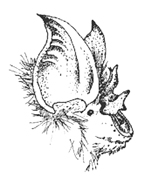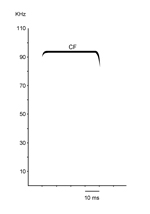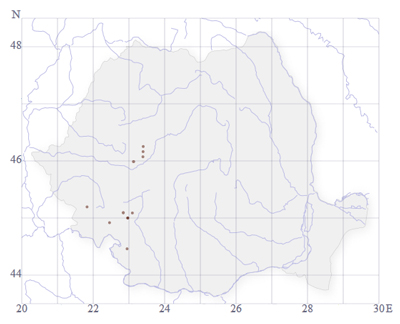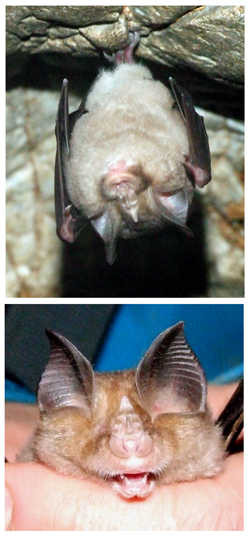Blasius patkósdenevér (Rhinolophus blasii)

(grafika: Moscu K.)

A Blasius-patkósdenevér CF típusú ultrahangja
| Română | liliacul cu potcoavă a lui Blasius |
| English | Blasius' horseshoe bat |
| Leíró, évszám | Peters 1866 |
Család |
Patkósdenevér-félék családja |
| Génusz | Patkósdenevérek génusza |
Alkar (cm) |
4.2 - 5.0 |
| Testtömeg (g) | 10 - 14 |
| Ultrahang tartomány [kHz] | 92-98 |
| Ultrahang típus | állandó frekvenciájú (CF) |
Földrajzi elterjedés |
globális elterjedési térkép |
| IUCN globális státusz | legkevésbé veszélyeztetett |
| Globális populációs trend | csökkenő |
| Nemzetközi védelme | Bern (App. II), Bonn (App. II)
EU Élőhely és Fajvédelmi direktíva (Ann. II & IV.) |
| Romániai státusa | Törvény által védett (90-10/05/2000) |

A faj elterjedése Romániában irodalmi és recens adatok alapján.
Közepes termetű patkósdenevér, világosbarna, homokszínű, esetleg sárgás bundával. A hasi és háti oldal bundaszíne között fokozatos az átmenet, a színek csekély mértékben térnek el egymástól. A lándzsa felfelé elkeskenyedik, a patkó széles. A nyereg felső karéja hegyes, hosszú, egyenes, nem görbül lefelé. A nyereg alsó karéja elölről nézve keskeny. A negyedik ujj első ujjperce a második ujjperc felénél hosszabb.

Kereknyergű patkósdenevér egyed szálláshelyén függeszkedve, illetve egy hálóval befogott egyed szemből.
Populációi Európában csupán a mediterrán területek keleti részén találhatóak (Horvátország, Balkán, Görögország, Törökország), illetve Bulgáriában és Románia délnyugati területein.
Ritka faj lévén, ökológiája nem teljesen tisztázott. Exkluzív barlanglakó faj. Romániában, múltbeli irodalmi források szerint ismertek voltak épületlakó kolóniák is, de ezek napjainkban nem lelhetőek fel. Vadászterületei változatosak, a mozaikos élőhelyektől nyílt területekig és bozótos vidékekig. Táplálékát kizárólag éjszakai lepkék teszik ki. Területhű faj, legtöbbször nem vándorol 10 km-nél messzebbre, a különböző évszakok szállásai általában pár kilométeres távolságban találhatók egymástól, sok esetben szomszédos barlangok.
Veszélyeztető tényezők és védelmi lehetőségek
Populációi veszélyeztetettek és csökkenő tendenciát mutatnak. Védelmi intézkedések lehetnek a barlangok látogatásának fokozott korlátozása, illetve az ismert kolóniák környékén a specifikus, mozaikszerű élőhelyek megőrzése.
Romániai tudományos munkák
Barbu P., Bazilescu E. (1977): Nouvelles données concernant l`espéce Myotis emarginatus Geoffroy en Roumanie. Analele Universităţii Bucureşti, ser. Biologie, 26: 93-94.[PDF]
Bazilescu E. (1970): O specie de chiropter nouă pentru Oltenia, Myotis emarginatus. Revista Muzeelor, Bucureşti, 2: 146-147.[PDF]
Bazilescu E. (1971): Date asupra coloniei de lilieci de la Runcu - Gorj. Studii şi Comunicări, Muzeul de Ştiinţele Naturii Bacău, p. 359-363.[PDF]
Bazilescu E. (1983): Consideraţii asupra faunei de mamifere din Oltenia şi propuneri pentru ocrotirea speciilor rare. Studii şi Cercetări, Drobeta Turnu-Severin, p. 195-199.[PDF]
Dumitrescu M., Tanasachi J., Orghidan T. (1955): Contribuţii la studiul biologiei chiropterelor. Dinamica si hibernaţia chiropterelor din Peştera Liliecilor de la Mănăstirea Bistriţa. Buletin Ştiinţific, Academia R.P.R., Secţia de Sţiinţe Biologice, Agronomice, Geologice şi Geografice, Bucureşti, VII(2): 319-357.[PDF]
Dumitrescu M., Tanasachi J., Orghidan T. (1962-1963b): Răspândirea chiropterelor în R.P. Română. Travaux de l'Institut de Spéologie "Émile Racovitza", Bucureşti, XXXIV: 509-575.[PDF]
Földváry D. (1906): A csúcsosnyergű patkósdenevér (Rhinolophus blasii Ptrs) Magyarországon. Állattani Közlemények, 5(3-5): 140-146.[PDF]
Murariu D. (2002): Contributions to the knowledge of mammal fauna (Mammalia) from south west Romania. Travaux du Muséum National d'Histoire Naturelle "Grigore Antipa", XLIV: 431-441.[PDF]
Nagy L.Z., Barti L., Dóczy A., Jére Cs., Postawa T., Szántó L., Szodoray-Parádi A., Szodoray-Parádi F. (2005): Survey of Romania's underground bat habitats Carpathian's underground bat habitats. Status and distribution of cave dwelling bats (2002-2004). Final report for the BP Conservation Programme. Survey of Southern and Western Carpathians underground bat habitats & Survey of Eastern Carpathians and Dobrogea underground bat habitats, Ed. Lizard, Cluj, pp. 44.[PDF]
Negrea A., Botoșăneanu L., Negrea Şt. (1967): Documents pour servir à la connaissance de la faune de mammifères des grottes du Banat (Roumanie). International Journal of Speleology, 2(4): 341-353.[PDF]
Topál Gy. (1954): A Kárpát-medence denevéreinek elterjedési adatai. A Magyar Nemzeti Múzeum Természettudományi Osztályának Évkönyve, Budapest, 46: 471-483.[PDF]
Nemzetközi tudományos munkák
- Csorba G., Ujhelyi P., Thomas N. (2003): Horseshoe bats of the world (Chiroptera: Rhinolophidae). Alana Books- Dietz C., Helversen O., Nill D. (2007):
Rhinolophus blasii. Handbuch der Fledermäuse Europas und Nordwestafrikas. Kosmos Verlag, Stuttgart. Pp. 195-99.
- Ohlendorf, B. (szerk.) (1995): Zur Situation der Hufeisennasen in Europa. Arbeitskreis Fledermäuse Sachsen-Anhalt e.v., Stecklenberg.
- Paunovic M., Stamenkovic S. (1998): A revision of the distribution and status of
Rhinolophus euryale and
Rhinolophus blasii in Yugoslavia, based on the discrimination properties of distinctive morphological characters. Myotis, 36: 7-23.
- Siemers B.M., Ivanova T. (2004): Ground gleaning in horseshoe bats: comparative evidence from
Rhinolophus basii,
R. Euryale and
R. Mehelyi. Behavioral Ecology and Sociobiology, 56: 464-471.















